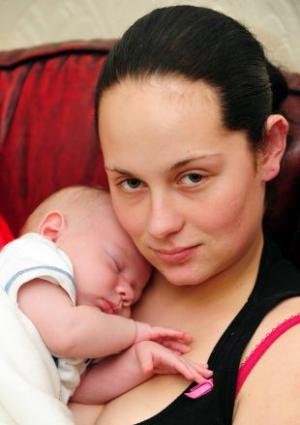Glynn Johnson sat silent and calm as the jury of eight men and four women returned the verdict to the court.
The jury took less than an hour to return the verdict at Plymouth Crown Court yesterday. Thursday
The 21-year-old was accused of inflicting grievous bodily harm on Alfie, leaving him with four bleeds in the membrane around the brain.
On Wednesday he told the court he ‘violently’ shook his son to ‘jolt’ him after the baby collapsed and vomited.
Johnson denied the charge, and also the lesser charge of actual bodily harm offered to a jury as an alternative verdict at Plymouth Crown Court on Wednesday.
On Wednesday the court heard that Alfie was admitted to Derriford Hospital in July 2008. Johnson allegedly found Alfie collapsed in his baby bouncer and had shaken the child to revive him.
Johnson told the court that on the afternoon in question, Alfie had started to ‘whinge’.
Johnson, of Royal Navy Avenue, had picked Alfie up; the baby projectile-vomited and went limp. Johnson said he panicked and shook Alfie before going to the kitchen, collapsing to his knees and then spotting the neighbours who came to help.
The court heard from doctors that Alfie had suffered subdural collections of blood.
During a court hearing on Tuesday Dr Neil Stoodley, a consultant neuroradiologist who studied CT and MRI scans of Alfie, told the court he believed the child’s damages were ‘non-accidental injuries caused by shaking’.
The defendant, the court heard, was in a relationship with Stacey Neville for six weeks when she found she was she pregnant.
When Alfie was born the couple were no longer together but Johnson was keen to be involved as a father.
The trial lasted four days.
http://www.thisisplymouth.co.uk/news/Youg-father-guilty-injuring-shaken-baby/article-2915472-detail/article.html
The jury took less than an hour to return the verdict at Plymouth Crown Court yesterday. Thursday
The 21-year-old was accused of inflicting grievous bodily harm on Alfie, leaving him with four bleeds in the membrane around the brain.
On Wednesday he told the court he ‘violently’ shook his son to ‘jolt’ him after the baby collapsed and vomited.
Johnson denied the charge, and also the lesser charge of actual bodily harm offered to a jury as an alternative verdict at Plymouth Crown Court on Wednesday.
On Wednesday the court heard that Alfie was admitted to Derriford Hospital in July 2008. Johnson allegedly found Alfie collapsed in his baby bouncer and had shaken the child to revive him.
Johnson told the court that on the afternoon in question, Alfie had started to ‘whinge’.
Johnson, of Royal Navy Avenue, had picked Alfie up; the baby projectile-vomited and went limp. Johnson said he panicked and shook Alfie before going to the kitchen, collapsing to his knees and then spotting the neighbours who came to help.
The court heard from doctors that Alfie had suffered subdural collections of blood.
During a court hearing on Tuesday Dr Neil Stoodley, a consultant neuroradiologist who studied CT and MRI scans of Alfie, told the court he believed the child’s damages were ‘non-accidental injuries caused by shaking’.
The defendant, the court heard, was in a relationship with Stacey Neville for six weeks when she found she was she pregnant.
When Alfie was born the couple were no longer together but Johnson was keen to be involved as a father.
The trial lasted four days.
http://www.thisisplymouth.co.uk/news/Youg-father-guilty-injuring-shaken-baby/article-2915472-detail/article.html







